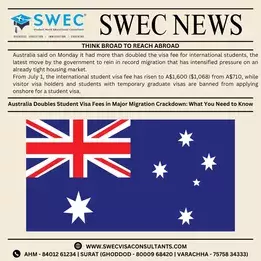Were you looking to study in Australia in 2024? Be prepared for a steeper price tag! The Australian government recently increased student visa fees by more than double, aiming to manage immigration levels.
What’s the change?
- The student visa fee has jumped from A$710 to A$1,600 (approx. ₹83,000 to ₹1,89,000).
- Visitor visa holders and students on temporary graduate visas can no longer apply for a student visa while already in Australia.
Why the change?
The government aims to:
- Reduce overall immigration numbers.
- Address a tight housing market impacted by high migration.
- Improve the integrity of the student visa system.
How does this compare?
This fee hike makes studying in Australia more expensive than competitor countries like the US (around $185) and Canada (around C$150).
Additional Regulations
- Stricter English language requirements were introduced in March 2024.
- The minimum savings required for a student visa increased to A$29,710 (approx. ₹35,20,000) in May 2024.
- Loopholes allowing students to extend their stay through multiple student visas are being closed.
Impact on Universities
Universities Australia, an industry body, expressed concern that these policies could harm the sector. International student fees are a significant revenue source for Australian universities.
Conclusion
Australia’s recent decision to significantly increase student visa fees and tighten visa regulations presents a challenge for international students considering Australia for their studies. The steeper costs and stricter application process might make other destinations with lower fees and more relaxed rules seem more appealing. This policy shift could potentially impact Australia’s international education sector, which relies heavily on student fees. Whether Australia can effectively manage immigration while attracting international students remains to be seen.
Frequently Asked Questions on Australia’s Increased Student Visa Fees and Regulations (July 2024)
Q1. How much more expensive is a student visa for Australia now?
Ans1. The student visa fee has more than doubled, from A$710 to A$1,600 (approx. ₹83,000 to ₹1,89,000).
Q2. Why did Australia raise student visa fees?
Ans2. The Australian government aims to reduce overall immigration and address a tight housing market impacted by high migration. They also want to improve the integrity of the student visa system.
Q3. Are there any other changes to student visas besides the fee increase?
Ans3. Yes, there are additional regulations:
- Stricter English language requirements were introduced in March 2024.
- The minimum savings required for a student visa increased to A$29,710 (approx. ₹35,20,000) in May 2024.
- Loopholes allowing students to extend their stay through multiple student visas are being closed.
Q4. Will these changes affect my application if I’m already in process?
Ans4. The new fees likely apply to new applications submitted after July 1, 2024. It’s best to check with the official Australian government immigration resources for the latest updates.
Q5. How does the new fee compare to other countries?
Ans5. Studying in Australia is now more expensive than competitor countries like the US (around $185) and Canada (around C$150).
Q6. Do I need to show more money in savings now for a student visa?
Ans6. Yes, the minimum required savings amount increased to A$29,710 in May 2024.
Q7. Can I still use scholarships or sponsor letters to meet financial requirements?
Ans7. Yes, scholarships and sponsor letters can still contribute to demonstrating your financial ability for the visa application.
Q8. Can I still apply for a student visa from within Australia if I’m on a visitor visa?
Ans8. No, visitor visa holders and students on temporary graduate visas can no longer apply for a student visa while already in Australia.
Q9. How will these stricter regulations affect the processing time for student visas?
Ans9. The impact on processing times is not yet clear. It’s advisable to check the official Australian government immigration website for the latest updates.
Q10. Should I consider studying in a different country now?
Ans10. Australia’s new visa fees and regulations might make other destinations with lower costs and easier processes more attractive. Consider all factors including program offerings, living costs, and your overall study goals when making your decision.
Q11. Will these changes hurt Australia’s international education sector?
Ans11. Universities Australia, an industry body, expressed concern that these policies could reduce revenue from international student fees. The long-term impact remains to be seen.
Q12. Is Australia no longer a good option for international students?
Ans12. Australia may still be a great choice for some students depending on their priorities and program options. However, the increased costs and stricter regulations are a significant factor to consider.





